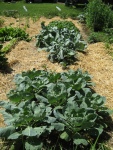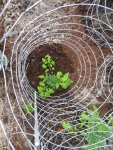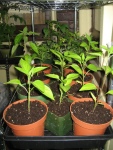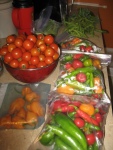I am currently in Zone 5, but lived for a long time in Zone 4, so I am no stranger to cold climate gardening. It can be more challenging, but also somehow more rewarding! Some of my plants spend as much of their lives indoors as out, but I love every step of the process, and there is really nothing better than the taste of a fresh cherry tomato bursting with flavor! An oldie but goodie, I have used the Alaska Gardening Guide by Ann Roberts as a guideline for much of my gardening in a colder climate. The average growing season listed for Anchorage, Alaska is 120 days. This means that you want to pick varieties of vegetables that will fit within that time frame.
I have found that it is easier to learn the basics of growing and gardening before trying to extend the growing season with cold frames or greenhouses, but that is just my experience and yours may vary depending on the amount of things you like to tackle at once! My first year gardening, I picked some basic varieties and also picked a couple of things that I was curious about, but not sure if I wanted to grow on a regular basis. Every year, I try to fine tune what varieties I like the best, grow those varieties, plus a couple of extras just for fun. By doing this, I have learned what things I like, added some new ones, and lost a few!
I have found several different numbers for last and first frost dates for Anchorage, but it looks like the average last frost is May 19th, with the average first frost being September 10th. If you plug this date into the Seed Start Chart at http://www.yougrowgirl.com/2006/03/31/the-lazy-gardeners-seed-starting-chart/ you will find the dates to plant in the ground as well as when to start seed. Our first frost here in West Virginia is the same as Anchorage, but our last frost is later, so I will be starting much of my garden at the same time. For the indoor starters, I always start some early tomatoes by March 10th, along with some onion seeds, and artichoke. The bulk of what I started was late March/early April. The second round I started more tomatoes, cabbage, celery, peppers, broccoli, basil, oregano, parsley, and thyme. The third round I started at the end of April/early May: cantaloupe, cabbage, okra, broccoli, cauliflower, lettuce, and cucumber.
My planting in the ground rotation looks like this:
- Late April: Lettuce, Peas, Spinach, and onion
- Early May: Broccoli, Brussel Sprouts, Cabbage, Carrots, Potatoes, and a few Tomatoes
- Late May or Early June: Beans, Cauliflower, Corn, Cucumber, Melon, Okra, Peppers, Pumpkin, Squash, and the remaining Tomatoes
The first two years, I planted a little bit of everything. This year, I am drastically changing my garden layout to include more of what I really like, and I am basing it on a cost-to-buy idea. I used to grow cabbage, but cabbage is incredibly cheap to buy, and I do not use much of it. My basic garden this year will include: Potatoes, Okra, Yams, Snap Peas, Green Beans, Hot Peppers, Sweet Peppers, Spaghetti Squash, Butternut Squash, Lettuce, Tomatoes, Cucumber, Carrots, Broccoli and Cauliflower, Brussel Sprouts, and Summer Squash. My herb garden includes: Basil, Oregano, Thyme, Sage, Cilantro, Peppermint, and Cumin.
If I had to pick 4-5 veggies to start with in Alaska, I would choose the ones that I enjoy eating the most and the ones that are SO much tastier fresh than from a store. For me, that would be: Sugar Snap Peas and Snow Peas, Tomatoes, Potatoes or Yams, Green Beans (Bush not Pole), and Squash (winter and summer). Peas will do very well in Alaska, potatoes should do well, green beans should do well. You will have to work a little bit harder for the squash and yams, but they are worth it! We have found that the more we eat from the garden, the more we want to eat! Our first year, the only veggies that I bought were broccoli and some potatoes late in the Spring. Everything else came from the garden. If we ran out, we didn’t eat it until we grew more! This year, I still have frozen zucchini from two years ago, and am whittling away at the canned green beans, onions, potatoes, tomatoes, and various peppers. We also still have pickles, pickled okra, and pickled pepper, along with various jellies. It is a huge amount of work, but there is just nothing more satisfying or tasty. The vegetables that you grow in your own garden have so much more nutritional value than anything in the store. Being in a northern climate can be more challenging, but all the more worth it in my opinion!
- Peas!!
- Peas and Broccoli
- Cabbage and Broccoli
- Early Tomatoes!
- Peppers
- Garden Bounty





